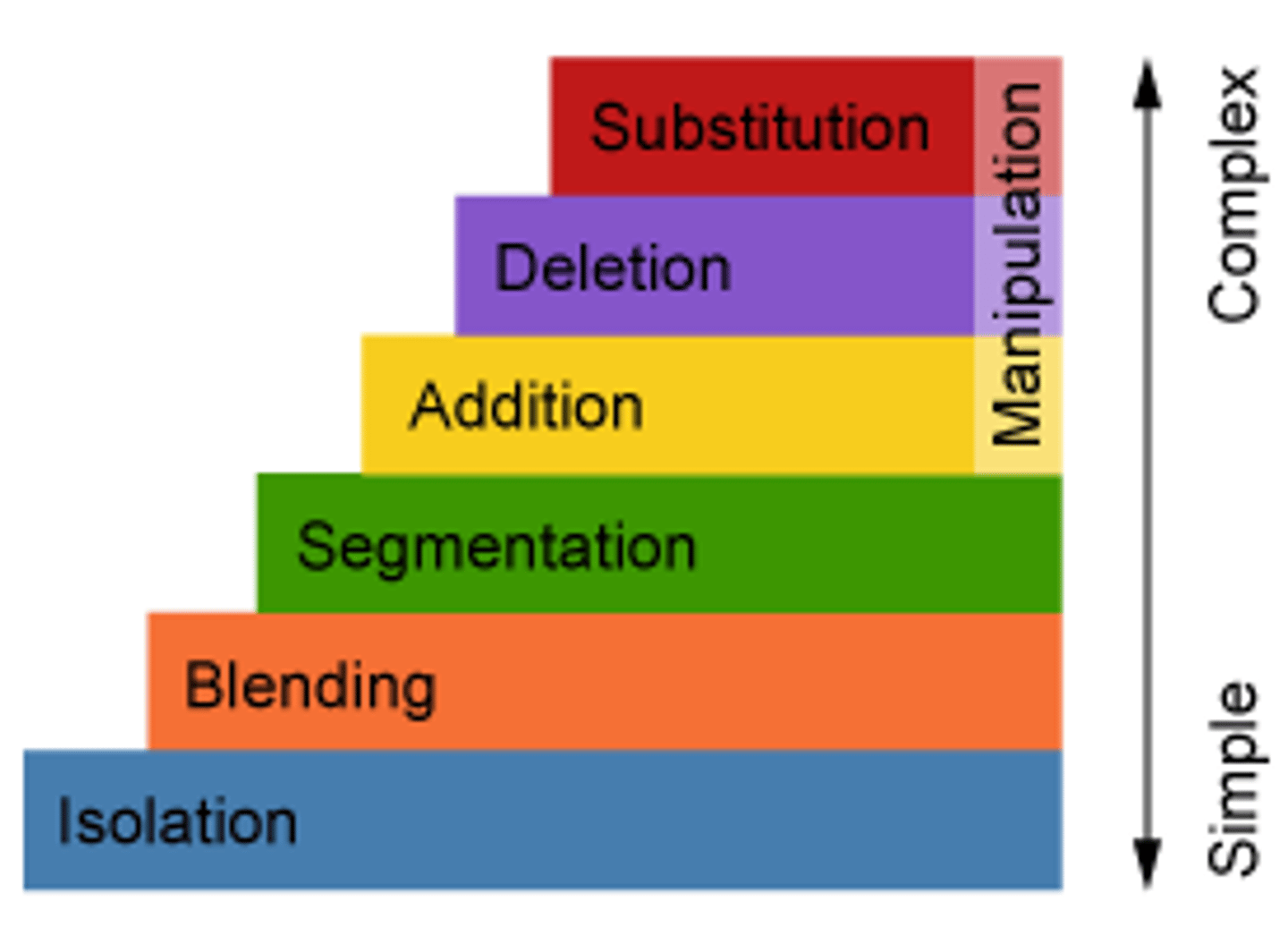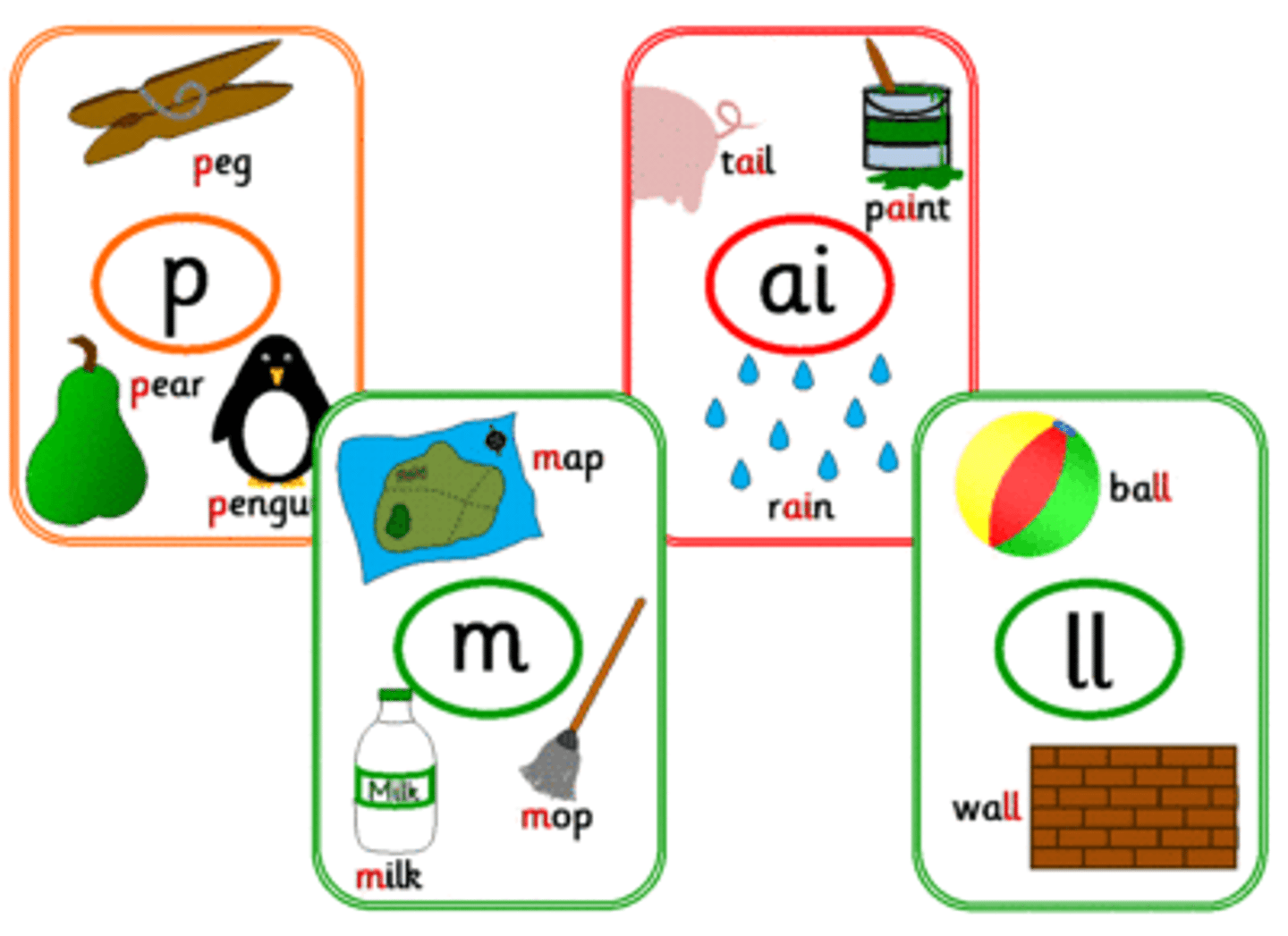RICA: Subtest 1
1/67
There's no tags or description
Looks like no tags are added yet.
Name | Mastery | Learn | Test | Matching | Spaced |
|---|
No study sessions yet.
68 Terms
Phonological Awareness
the ability to reflect on and manipulate the sound structure of spoken language

Phonemic Awareness
The ability to hear, identify,and manipulate the individual sounds, phonemes, in oral language.

Phoneme
speech sound in a language
Grapheme
A written representation of a sound using one or more letters.

Vowels
a, e, i, o, u
Onset and Rime
-Parts of spoken language that are smaller than syllables but larger than phonemes
-Onset is the initial consonant(s) sound of a syllable (the b- of bag; the sw- of swim)
-Rime is the part of the syllable that contains the vowel and all that follows it (the -ag of bag; the -im of swim)
Word Awareness
knowing that individual words make up a sentence
Syllable Awareness
Counting, tapping, blending, or segmenting a word into syllables.
Syllable Blending
the ability to put together parts of a word and make them into a new word
Sound Isolation
Give student a word, which sound occurs at beginning, middle and end
Sound Identity
Student needs to know the same sound in words
Sound Blending
Teacher says sounds with brief pauses and student reads and says word
Sound Substitution
Teacher asks child to substitute one sound for another to create a new word
Sound Segmentation
Isolate and identify the sounds in a spoken word
Yopp-Singer Test
tests phonemic segmentation. This is a test of a student's ability to separately articulate the sounds of a spoken word in order. Given individually. K-2nd grade.
Concepts About Print (CAP)
Assesses the literacy knowledge of kindergarten children and early first graders. Skills assessed: book handling skills, directionality, word-by-word matching, locating words in print, etc. CAP lets teachers know what children understand about print.
Meaning
printed words convey meaning
Representation
To understand a letter or word
Directionality
Ability to track print. Left -> or Right Top -> Bottom
Book Handling Skills
knowing how to handle a book and how books "work" (i.e., front and back cover, left to right sweep)
The Shared Book Experience
Teachers use big books. includes introduction (prereading) ask predictive questions. read story with dramatic punch and point to text (tracking of print). Have discussion, reread on subsequent days with the whole group
Letter Recognition
ability to identify a grapheme by its name
Letter Naming
The ability to say the name of a letter when the teacher points to it.
Letter Formation
ability to write the lower and uppercase letters legibly. teaching names of letters, not sounds.
Alphabetic Principle
an understanding that letters and letter patterns represent the sounds of spoken words.
Phonics
the study of the sounds of the letters of the alphabet
Word Identification
Ability to read aloud, or decode, words correctly.
Word Recognition
the process of identifying a unique pattern of letters
Automaticity Theory
2 main tasks of the reader; 1. To decode words 2. To understand meaning of the text
Morphological Clues
Clues used to identify words when they rely on root words, prefixes, and suffixes.
Sight Words
words children identify quickly, accurately, and effortlessly.
Context Clues
Clues in surrounding text that help the reader determine the meaning of an unknown word
Structural Analysis
A procedure for teaching students to read words formed with prefixes, suffixes, or other meaningful word parts.
Syllabic Analysis
Process of recognizing words by analyzing the syllables in a word
High Frequency Words
Words most often used in the English language
Want to Know Words
Words children would like to learn Ex: McDonalds or Disneyland
Irregular Spelt Words
a word that is spelled contrary to the way it sounds
Content Area Words
vocabulary which relates to class subjects or professions
Automaticity
the ability to process information with little or no effort
comprehension
the process of extracting meaning from a sequence of words
Fluency
smoothness of speech
Word Recognition
the process of identifying a unique pattern of letters
Consonant
speech sounds made with lips, tongue or teeth
Consonant Sounds
The ______________ are sounds made mostly with the lips, teeth, or tongue, such as m, r, t, s, k, f, etc.
Stop Sounds
These are sounds in words that when they are said, you have to stop your tongue to release the air. It is with these letters:T-D-P-K-G
Consonant Digraph
a consonant cluster that makes only one sound (sh, ch, th, wh, ph)
Long Vowels
say their name
Short Vowels
don't say their name, but make sounds instead
Vowel Diagraph
Two vowels comibne to make a single sound
Dipthongs
two vowels to make another sound, oe in "shoe"
R-Controlled Words
EXAMPLES: water, her, winter, fur, purr, turn, bird, girl, third, or, bar, spar, star, jar
L-Controlled Words
Examples: Milk, Bull, Chill, Pull, etc
Pre-Fix
A word part that is attached to the begining of a word root to modify the word's meaning.
Suffix
A word or letter placed after the root.
Common Word Patterns
with increasing difficulty starting with: VC, CVC, CVCC, CCVC, CVVC, CVCe
Syllable Patterns
The alternative patterns of consonants (C) and vowels (V) at the point where syllables meet.
1. Precommunicative Spelling
2. Semiphonetic Spelling
3. Phonetic spelling
4. Transitional Spelling
5. Conventional Spelling
1. uses symbols from the alphabet but no knowledge of letter-sound correspondence
2. when children have some letter awareness. They may spell a lengthy word with a few letters, spelling play as "pa" or talk as "tk."
3. Using sound awareness to guess letters and combinations of letters
4. Students use some conventional spelling but still misspell many irregular words.
5. When children know and use most basic spelling rules and spell most words correctly.
Part-to-Whole
a - > at -> cat -> sentence -> passage
Whole to Part
passage -> sentence -> word (at) -> letter (sound)
Orthographic Knowledge
knowledge of common letter patterns that skilled readers use rapidly and accurately to associate with sounds
Morpheme
in language, the smallest unit that carries meaning
Bound Morpheme
a morpheme that cannot stand alone as a word
Free Morpheme
a morpheme that can stand alone as a word
Closed Morpheme
A syllable that ends with a consonant
Fluency
the feeling of ease associated with processing information
Accuracy
Words correct per minute
Rate
the speed at which a person speaks
Prosody
the patterns of rhythm and sound used in speech